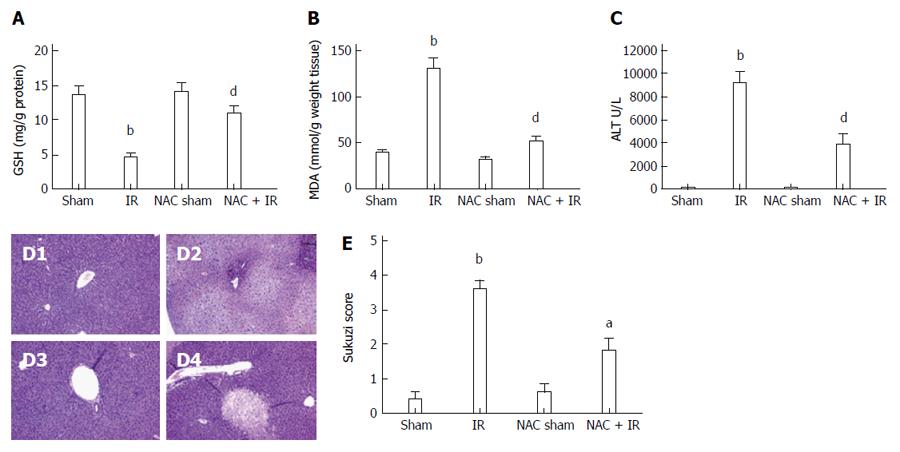Copyright
©2014 Baishideng Publishing Group Inc.
World J Gastroenterol. Nov 7, 2014; 20(41): 15289-15298
Published online Nov 7, 2014. doi: 10.3748/wjg.v20.i41.15289
Published online Nov 7, 2014. doi: 10.3748/wjg.v20.i41.15289
Figure 1 N-acetylcysteine treatment attenuates reactive oxygen species-induced liver injury after ischemia-reperfusion.
Mice were subjected to 90 min partial liver ischemia, followed by 6 h reperfusion. A and B: reactive oxygen species levels evaluated by glutathione (mg/g protein) and malondialdehyde (nmol/g tissue); mean ± SD, n = 3-5/group, bP < 0.01 vs sham group; dP < 0.01 vs IR group; C: hepatocellular function evaluated by alanine aminotransferase (U/L); mean ± SD, n = 3-5/group, bP < 0.01 vs sham group; dP < 0.01 vs IR group; D: histopathological analysis of livers harvested 6 h after reperfusion: D1: sham group: normal hepatic architecture; D2: IR group: severe hepatic lobule distortion, sinusoidal congestion, apparent edema, vacuolization and massive necrosis; D3: NAC sham group: normal hepatic architecture; D4: NAC + IR group: mild vacuolization, punctate necrosis and edema; E: severity of liver IRI by Suzuki’s histological grading; mean ± SD, n = 3-5/group, bP < 0.01 vs sham group; aP < 0.05 vs IR group. NAC: N-acetylcysteine; IR: Ischemia-reperfusion; ALT: Alanine aminotransferase.
- Citation: Sun Y, Pu LY, Lu L, Wang XH, Zhang F, Rao JH. N-acetylcysteine attenuates reactive-oxygen-species-mediated endoplasmic reticulum stress during liver ischemia-reperfusion injury. World J Gastroenterol 2014; 20(41): 15289-15298
- URL: https://www.wjgnet.com/1007-9327/full/v20/i41/15289.htm
- DOI: https://dx.doi.org/10.3748/wjg.v20.i41.15289









